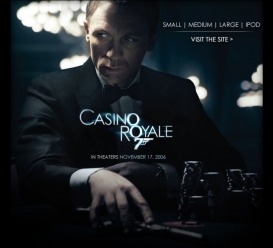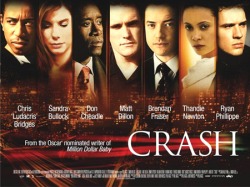Globalisation
As our understanding of the world has grown and expanded, so has the film industry. Hollywood studios have offices dotted all over the globe, giving them the ability to film anywhere in the world. They also have a wider range of actors who no longer just work on films within their own country, but can be flexible with the projects they take on. The film industry has become global or even globalised, ignoring national boundaries and interlinking people and projects from all over the world, taking full advantage of any resources that are available to them.
Hjort and MacKenzie describe this new term globalisation, as well as other related words, stating that:
...over the past ten years or so, we have seen a dramatic shift from this sort of theory to what is beginning to look like a promising emphasis of relevant cultural, social and historical contexts in accounts of literature, film and other arts. More specifically, the influential critical vocabulary associated with deconstruction and psychoanalytic semiology must compete with a new set of terms: 'hybridity', 'multiculturalism', 'transnationalism', 'nationalism', 'internationalism', globalisation', 'cosmopolitanism', 'exile', 'postcolonialism', to mention but some of the most salient terms. While the specific meaning of some of these terms -'hybridity' is a good example- is linked to poststructuralist premises, many of the terms bring into play concepts and approaches that attempt to mediate successfully between macrosociological and agential levels of description (Hjort & MacKenzie, 2000, p. 1).
To describe all of these new terms succinctly, the term hybridity seems appropriate. Transnational and globalised films are hybrids of many nations, cultures and creative minds, making them a melting pot of representations and interpretations. The Bond franchise is perhaps the only series of films that has consistently recreated this hybrid nature of film production and film context.
Hjort and MacKenzie describe this new term globalisation, as well as other related words, stating that:
...over the past ten years or so, we have seen a dramatic shift from this sort of theory to what is beginning to look like a promising emphasis of relevant cultural, social and historical contexts in accounts of literature, film and other arts. More specifically, the influential critical vocabulary associated with deconstruction and psychoanalytic semiology must compete with a new set of terms: 'hybridity', 'multiculturalism', 'transnationalism', 'nationalism', 'internationalism', globalisation', 'cosmopolitanism', 'exile', 'postcolonialism', to mention but some of the most salient terms. While the specific meaning of some of these terms -'hybridity' is a good example- is linked to poststructuralist premises, many of the terms bring into play concepts and approaches that attempt to mediate successfully between macrosociological and agential levels of description (Hjort & MacKenzie, 2000, p. 1).
To describe all of these new terms succinctly, the term hybridity seems appropriate. Transnational and globalised films are hybrids of many nations, cultures and creative minds, making them a melting pot of representations and interpretations. The Bond franchise is perhaps the only series of films that has consistently recreated this hybrid nature of film production and film context.
Casino Royale (d. Campbell, 2006)

Like the Bond films that proceeded and followed it, Casion Royale boasts exotic locations and foreign villains and temptresses. However, do these elements make it definable as a transnational film?
The film involved an international cast and crew including:
And the many exotic locations within the film include the Czech Republic, Italy, the Bahamas and Buckinghamshire, Surrey, UK. However, while Casino Royale crosses borders using international actors and crew and filming all over the world, it could be considered just to be a Hollywood film that exoticises the foreign landscape and persona without saying anything about transnationality.
In Edward. W. Said's Introduction to Orientalism (1979) he speaks of how the West, or the 'Occident', has constructed an exoticised view of the East, or the 'Orient' which does in actual fact not exist. He states, "The Orient was almost a European invention, and had been since antiquity a place of romance, exotic beings, haunting memories and landscapes, remarkable experiences" (Said, 1979, p. 71). Although Said refers to Asia in his article, I belief that the same theory of exoticism can be applied to other countries, therefore forming the stereotype found in the James Bond genre of evil forgein diplomats and sexy exotic women. It could be viewed, when applying Said's theory to the Bond franchise that rather than encouraging transnationality the makers of the films are reenforcing stereotypes instead.
The film involved an international cast and crew including:
- Director - Martin Campbell (New Zealand)
- Daniel Craig & Judy Dench (British)
- Eva Green & Simon Abkarian (French)
- Mads Mikkelsen (Danish)
- Giancarlo Giannini & Caterina Murino (Italian)
- Jeffrey Wright (American)
And the many exotic locations within the film include the Czech Republic, Italy, the Bahamas and Buckinghamshire, Surrey, UK. However, while Casino Royale crosses borders using international actors and crew and filming all over the world, it could be considered just to be a Hollywood film that exoticises the foreign landscape and persona without saying anything about transnationality.
In Edward. W. Said's Introduction to Orientalism (1979) he speaks of how the West, or the 'Occident', has constructed an exoticised view of the East, or the 'Orient' which does in actual fact not exist. He states, "The Orient was almost a European invention, and had been since antiquity a place of romance, exotic beings, haunting memories and landscapes, remarkable experiences" (Said, 1979, p. 71). Although Said refers to Asia in his article, I belief that the same theory of exoticism can be applied to other countries, therefore forming the stereotype found in the James Bond genre of evil forgein diplomats and sexy exotic women. It could be viewed, when applying Said's theory to the Bond franchise that rather than encouraging transnationality the makers of the films are reenforcing stereotypes instead.
Multiculturalism
The term multiculturalism is similar to that of transnational. While transnational applies to a mixture of people from different countries, multicultural refers more to people of differing ethnicity and race. Shohat and Stam (2003) describe the term multiculturalism as:
...for the Right too radical, a social revolution that empowers Native Americans, African Americans, Latinos, and white radicals and thus balkanizes American society. For a certain Marxist Left, meanwhile, multiculturalism is not radical enough; it is a cultural diversion from the real issues of class and political economy...Some Left intellectuals like Tod Gitlin worry less about multiculturalism dividing the nation than its dividing the movement, through distracting ivory-tower debates about race (Shohat & Stam, 2003, p. 6).
This shows that multiculturalism brings with it a lot of debate. This debate is explored in the film Crash (d. Haggis, 2004) which focuses on a mixture of characters of mixed races with interlinking storylines. Below is the trailer to the film which addresses many of the issues in the film. At the beginning of the trailer a Black character states "It's the sense of touch. Any real cities, you walk you know, you brush past people, people bump into you. In LA no one touches you, we're always behind this metal and glass." Taken literally this could mean that people go around in their cars not interacting with anyone, but metaphorically it could mean that people don't mix with one another and therefore form prejudice views of 'different' or 'multicultural' people.
...for the Right too radical, a social revolution that empowers Native Americans, African Americans, Latinos, and white radicals and thus balkanizes American society. For a certain Marxist Left, meanwhile, multiculturalism is not radical enough; it is a cultural diversion from the real issues of class and political economy...Some Left intellectuals like Tod Gitlin worry less about multiculturalism dividing the nation than its dividing the movement, through distracting ivory-tower debates about race (Shohat & Stam, 2003, p. 6).
This shows that multiculturalism brings with it a lot of debate. This debate is explored in the film Crash (d. Haggis, 2004) which focuses on a mixture of characters of mixed races with interlinking storylines. Below is the trailer to the film which addresses many of the issues in the film. At the beginning of the trailer a Black character states "It's the sense of touch. Any real cities, you walk you know, you brush past people, people bump into you. In LA no one touches you, we're always behind this metal and glass." Taken literally this could mean that people go around in their cars not interacting with anyone, but metaphorically it could mean that people don't mix with one another and therefore form prejudice views of 'different' or 'multicultural' people.
Crash (d. Haggis, 2004)

The film looks closely at the issue of racism and of how people of different ethnicities lead different lives. One of the most shocking storylines in the film is that of a mixed race couple who are pulled over by a white racist policeman and then sexually molests the female. She is later rescued from a car crash by the same policeman. This storyline portrays the problem of racism in America within a multicultural society and how at the end of the film the characters overcome their differences realising they are, after all, people - all exactly the same. This film engages the debate in multiculturalism in connection to racism and how white Americans have more power than Americans of other ethnic backgrounds. This is emphasised by the policeman being white, the police being a symbol of authority and power.
